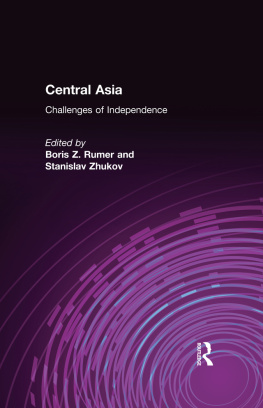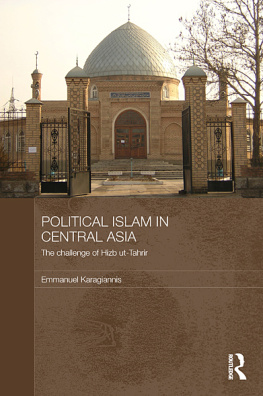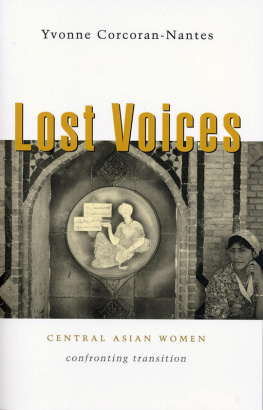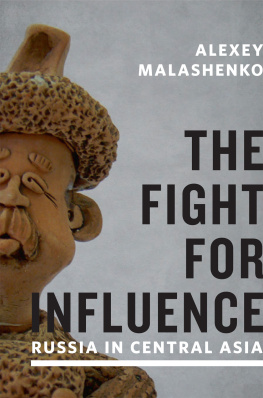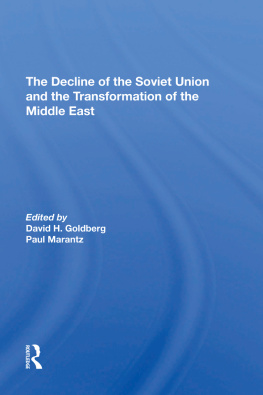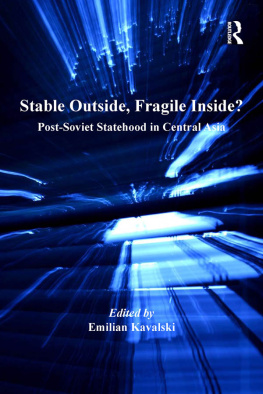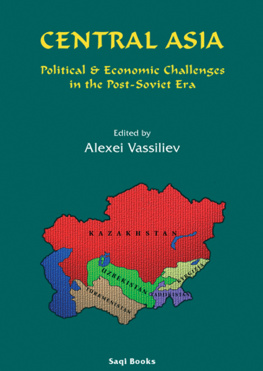First published 1991 by Westview Press, Inc.
Published 2019 by Routledge
52 Vanderbilt Avenue, New York, NY 10017
2 Park Square, Milton Park, Abingdon, Oxon OX14 4RN
Routledge is an imprint of the Taylor & Francis Group, an informa business
Copyright 1991 Taylor & Francis
All right reserved. No part of this book may be reprinted or reproduced or utilised in any form or by any electronic, mechanical, or other means, now known or hereafter invented, including photocopying and recording, or in any information storage or retrieval system, without permission in writing from the publishers.
Notice:
Product or corporate names may be trademarks or registered trademarks, and are used only for identification and explanation without intent to infringe.
Library of Congress Cataloging-in-Publication Data
Soviet Central Asia : the failed transformation / edited by William Fierman : with a foreword by Teresa Rakowska-Harmstone.
p. cm.
Includes bibliographical references and index.
ISBN 0-8133-7907-5
1. Soviet Central AsiaPolitics and government.
2. RussificationSoviet Central Asia. 3. Soviet Central AsiaSocial conditions1917- . I. Fierman, William.
DK859.S68 1991
958'.408dc20
91-13398
CIP
ISBN 13: 978-0-367-28817-4 (hbk)
Stripped of political rhetoric of the "achievements of socialism" and "benefits of fraternal assistance," the fate of Soviet Central Asia represents perhaps the most tragic and least reversible example of the failure of the Soviet experiment that, in the name of an ideological goal, led to near destruction of a region, its peoples, and its culture.
Prior to the Gorbachev era even most skeptical observers accepted the claim that the modernization under Soviet rule brought significant benefits to the region, notwithstanding the costs of transforming a feudal imperial backwater into a showcase of Soviet "socialism." The Sovietstyle modernization was comparable in many respects to that introduced by Western imperial powers in their colonies, but it was more sweeping and was characterized by ideological and political constraints. A massbased education system, operating both in local languages and in Russian, stimulated the emergence of modernized elites. Development of indigenous cultures was promoted, modern communications systems were developed, and a network of state-run social and health services was set up. Last but not least, the region underwent an accelerated economic change and development as the Soviet Union's primary cotton producer. However inadequate the results were by Western standards (or even in comparison with the Soviet West), and however staggering the price, this change meant progress in a society whose growth had been arrested in the Middle Ages, and it compared favorably with neighboring countries.
Among the costs were the break-up of the region's natural unity and the destruction of the traditional society, which led to the suppression of Islam and violation of its cultural norms. It also meant the obliteration of successive generations of indigenous leaders who dared to defend local interests and the deaths of millions during the collectivization campaign. It also brought total subordination of local interests to Moscow.
In the light of glasnost, the benefits of Soviet-type progress in the Central Asian republics appear to have been, at best, a mixed blessing. Educational and cultural policies, determined by the center and ideologically slanted, were applied in total disregard of local needs and requirements, and carried a strong Russifying impact. The conflicting socialization by both traditional and modern agents opened the way for the emergence of culturally ambivalent elites. Caught between new Soviet (de facto Russian) values and their traditional Islamic roots, and between their dependence on Moscow and their need for support based in old kinship and regional ties, the elites acted as a go-between but did not fully identify either with the old or with the new community. The bearers of Moscow's messages and executors of Moscow's policies, they were distrusted locally. Yet they could not integrate into the new society because they were not accepted as equal by the Russians, who remained firmly convinced of the superiority of their culture and of their "civilizing mission" in the imperial periphery.
The indigenous communists were formally in charge of their republics. But "parachuted" functionaries of the central party and state apparat were placed in politically strategic positions throughout the region, while immigrants effectively manned the regional administrative and managerial infrastructure and dominated urban and industrial centers. Central Asia was flooded by Russians, other Slavs, members of other groups in pursuit of a warmer climate and better wages, and by successive waves of involuntary settlers. "Enemies of the people," individuals as well as entire social and national groups such as the kulaks and Soviet Germans and Crimean Tatars, were deported to the region. The Muslim masses, on the other hand, continued to dominate the countryside of cotton-growing kolkhozes and sovkhozes and persisted in their traditional life, refusing a change that would mean an acceptance of foreign ways.
The masses social resistance can be measured by their lack of progress in learning Russian, the effective language of universal communication in the Soviet Union and the indispensable tool for progress up the social, political, and economic ladder. The results of the last two Soviet population censuses (1979 and 1989) indicated that fully one-half to three-fourths of the native populations of Central Asia and Kazakhstan could not understand or speak Russian and that non-speakers of the language were more numerous among the young people than they were among the older generation. The resulting alienation between rural/ traditional/indigenous and urban/modernized/immigrant communities created an ideal breeding ground for ethnic conflict that became visible with the post-Stalin thaw, when central control and repression mechanisms were reduced and undermined.
After 1953, Muslim political elites were gradually able to gain greater political power in the management of local affairs, but the attitudes did not change on either side, and the conflict intensified. A return to traditional values and a revival of Islamic culture and religion in the Muslim community were accompanied by the growing assertion of local interests and demands in cultural, political, and economic life and an emergence of ethnic nationalism. While Islamic revival was region-wide, new nationalism aggregated on the basis of existing political-administrative structures and was articulated by the republics' indigenous political elites and supported by a wider and more broadly based Muslim cultural and professional intelligentsia. Understandably, local politicians sought the political power that had been denied them under Soviet rule and in so doing turned for approval and support to their national communities. Long-standing social, cultural, political, and economic grievances have all been placed in the context of new nationalism and national self-assertion.


